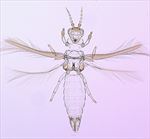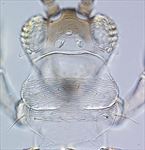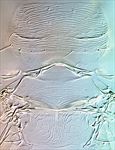
bhattii female [M.Masumoto]

bhattii head & pronotum [M.Masumoto]

bhattii fore wing [M.Masumoto]

mori hind tibia & tarsus

mori pro, meso & metanota

mori tergites VII-X
Generic diagnosis
Female macropterous. Head wider than long; ocellar setae pair I present, pair III between posterior ocelli; postocular setae minute or absent; maxillary palps 2-segmented. Antennae 8- to 9-segmented; segment I without paired dorso-apical setae; III and IV with sense-cones forked. Pronotum wider than long, two pairs of posteroangular setae. Mesonotum anteromedian campaniform sensilla absent. Metanotum with longitudinal lines on posterior half, median setal pair behind anterior margin; campaniform sensilla absent. Fore wings fully developed; anterior margin fringe cilia arise at wing margin; first vein with wide gap in setal row and two distal setae, second vein without row of setae; clavus with two veinal and one discal setae; posterior fringe cilia straight; apex of fore wing with one long seta. Prosternal ferna divided; basantra membranous and without setae. Mesosternal endofurca with spinula; metasternal endofurca U- or lyre-shaped and reaching mesothorax. Tarsi 1-segmented. Tergites without ctenidia or craspedum, with transverse or reticulate striae laterally usually bearing some internal dots or wrinkles; II–VIII median setae longer than distance between their bases; VIII with almost complete comb; IX without anterior campaniform sensilla; X without median split. Sternites without discal setae; sternites III–VII with 3 pairs of posteromarginal setae, II with 2 pairs; VII with all setae submarginal.
Male similar to female, sternites without pore plates.
Biological data
The species of Pseudodendrothrips all feed on leaves, and about half of these species are known to be associated with species of Moraceae (Masumoto & Okajima, 2017).
Distribution data
Pseudodendrothrips is a genus primarily from Asia, although P. mori has been widely distributed around the world in association with cultivated and wild mulberry plants, Morus niger [Moraceae]. Two species are listed from Brazil (ThripsWiki, 2020), but these probably belong to some other genus. Most of the species recorded in China are from the southern parts of the country.
Nomenclatural data
Pseudodendrothrips Schmutz, 1913: 998. Type species Pseudodendrothrips ornatissimus Schmutz, 1913, by monotypy.
This genus comprises 21 species (ThripsWiki, 2020), and the following six species have been recorded from China:
bhattii Kudo, 1984: 502.
fumosus Chen, 1980: 171.
lateralis Wang, 1993: 253.
mori (Niwa, 1908: 180). (Belothrips)
puerariae Zhang & Tong, 1990: 195.
ulmi Zhang & Tong, 1988: 278.
Relationship data
Thripidae sub-family Dendrothripinae: this is one of 12 genera currently recognised in this group (Mound & Tree, 2015). This sub-family comprises 105 species (ThripsWiki, 2020), almost all Old World in origin. All species have the metathoracic furca elongate, extending to the mesothorax. Species of Pseudodendrothrips have the hind tarsi exceptionally elongate, and the pronotum usually has a median transverse ridge. The body sculpture is remarkably uniform amongst the members of this genus, and in contrast to the species of Dendrothrips the fore wing anteromarginal cilia are close to the costal margin rather than ventrally behind it. Relationships of this genus are also discussed by Masumoto & Okajima (2017).
References
Masumoto M & Okajima S (2017) Studies on Dendrothripinae (Thysanoptera, Thripidae) from Japan, with new records and one new species. Zootaxa 4362: 405-420.
Mound LA & Tree DJ (2016) Genera of the leaf-feeding Dendrothripinae (Thysanoptera, Thripidae), with new species from Australia and Sulawesi, Indonesia. Zootaxa 4109 (5): 569–582.
ThripsWiki (2020) ThripsWiki - providing information on the World's thrips. <http://thrips.info/wiki/Main_Page>